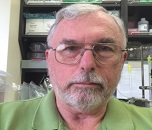Day 1 :
Keynote Forum
Rodica E. Ionescu
University of Technology of Troyes, France
Keynote: Ultrasenstive Biodetection of Worldwide Pathogens: From Classical Methods to Advanced Biosensing Technologies
Time : 09:45-10:30

Biography:
Rodica E. Ionescu is an associate professor of nano-biochemistry at the laboratory Light, nanomaterials and nano-technologies (L2n), University of Technology of Troyes. She earned one Ph.D. from the Ben-Gurion University of Negev (2004), in Biotechnological Engineering and a second PhD from the University of Bucharest (2007), in Chemistry. Recently, Dr. Ionescu was the scientific manager of a POC-NRF Grant “Electrochemical lateral flow biosensor for detection and quantification of dengue virus in whole blood” at the Nanyang Technological University, Singapore (2014-2015). Her current research activities include the development of portable multi-analytes biosensing and toxicity platforms for medical and environmental applications.
Abstract:
Recently, the world is experiencing with dramatic climatic changes, which have led either to the emergence or to the amplification of new pathogenic agents (bacteria and viruses for example). The most significant example is the appearance of the SARS-COvid-2019 virus which greatly slowed down various human activities at the beginning of 2020 due to several confinements which have followed one another in a wave of "stop and go" for more than two years in different areas of the globe. Therefore, many multidisciplinary research teams and private companies have been deeply involved in the development of rapid, portable and unique modern bioassays medical devices that greatly help the doctors/pharmacists/nurses to monitor the presence/absence of COvid virus. In this context, classical biotechnological methods such as polymerase chain reaction and radiological investigations have also been widely used despite their high prices, long procedures and long-term trained personnel. Moreover, the sensitivity and specificity of the assays based on lateral flow principles were many times questionable due to ineffective visibility to the human eye of colorimetric false/positive gold lines formed in the presence of very low COvid virus loads. Therefore, modern biosensing prototypes are needed to correlate virus/antibody concentration with CoVid infection status and occurrence of specific biomarkers, namely viral proteins in body fluids (nasal mucosa, saliva, blood, urine, etc). This conference focuses on recent disposable devices for biodetection of the COvid virus and its associated viral mutations. In addition, the biosensing of gliadins food allergens and Brettanomyces bruxellesis wine pathogens on miniaturized solid supports will also be addressed
Keynote Forum
Wen-Yih Chen
National Central University, Taiwan
Keynote: Investigating Surface Modification of Silicon Nanowire Field-Effect Transistor Biosensors to Quantify Cardiac Troponin I at High Resolution for Early-Stage Diagnosis of Acute Myocardial Infarction
Time : 10:30-11:15

Biography:
Dr. Wen-Yih Chen is currently a Distinguished Professor in the Department of Chemical and Materials Engineering and Institute of Biomedical Engineering, National Central University (NCU). He was the Chairman of the Department and was the Associated Dean of the Engineering School of NCU. He also was a visiting Professor of MIT, Monash University and U. of Washington, Seattle. His research emphases have been on understanding the thermodynamics and kinetics between biomolecular interactions. With the principle understanding of the molecular interactions, he has successfully elucidated some biochemical separations and protein folding disease phenomena in molecular level. Currently, he has devoted his research resources in biosensor development, especially in gene sequencing and biomarkers detection by Field Effect Transistor and Surface Plasmon Resonance. He has published more than 150 peer review papers and owned more than 40 patents, mostly in biosensor area. He is currently on the editorial board of Biotechnology Journal (SCI), Bioprocess and Bioengineering (SCI) and Atomic and Molecular Physics (SCI). He is one of the founders of a newly established company, Helios Bioelectronics Inc., Taiwan.
Abstract:
Cardiac troponin I (cTnI) has been referred to and considered as the gold standard for diagnosing acute myocardial infarction (AMI) and monitoring the variation of this biomarker in human blood within short period is critical for early-stage diagnosis of this disease. However, precisely quantifying cTnI is still challenging, especially at its ultra-low level, due to insensitivity and long time-to-result of the current techniques. The purpose of this study is to develop a biosensor, which can quantify cTnI at ultra-low concentrations in human serum with high resolution and short time-to-result for early-stage diagnosis of AMI.Methodology and Theoretical Orientation: The silica substrates were modified with (3-aminopropyl)triethoxysilane (APTES), 1-(3-aminopropyl)silatrane (APS), and silane-polyethylene glycol (silane-PEG) to immobilize cTnI aptamer as the bio-probe. The morphology and topology of the modified surfaces were investigated by atomic force microscopy (AFM) whereas their ability to resist non-specific foulants was also examined by fibrinogen adsorption. The SiNWFET aptasensors developed from these modification methods were employed to detect cTnI at ultra-low content and small increment in human serum.
Keynote Forum
Haniyeh Fayazfar
Ontario Tech University, Canada
Keynote: Advanced Manufacturing of Hybrid Nanocomposite Materials for Nano Biosensor Applications

Biography:
Dr Ramona (Haniyeh) Fayazfar is currently an assistant Professor in Mechanical and Manufacturing Engineering department at Ontario Tech University, Canada. Her main research concentrates on Nanostructured Composites/Hybrid Materials, Advanced Manufacturing (Nanofabrication and Additive Manufacturing), Electrochemical Synthesis of Nanostructured Materials, Advanced Coatings and Surface Treatment, Biosensors for Point-of-Care Diagnostics and Health Monitoring. The outcomes of her research have been published in high prestigious journals/conferences and covered by various media outlets. Prior to joining Ontario Tech, she was a postdoctoral fellow in Multi-Scale Additive Manufacturing group at University of Waterloo. She received her Bachelor’s, Master’s, and PhD degrees in Materials Science and Engineering from Sharif University of Technology, the top university in Iran. She was awarded the University commemorative plaque and medal from the President of SUT for being ranked first among all graduated
Abstract:
Development of advanced nanocomposite materials with multifunctional properties provides unique possibilities.To this end, a low-cost and eco-friendly electrochemical method was developed to chemically functionalize CNT surfaces and incorporate them with less-common shapes of gold nanostructures (nanoparticles, nanoflowers, nanopines, nanodendrites) to make highly electroactive modified electrodes for biosensor applications. This research was novel in its depth of analysis and has provided fundamental knowledge for architectural control and uniform distribution of nanosized gold with well-defined shapes on CNTs in a nanocomposite layout by simply controlling process parameters, which is critical towards future nanodevices.
- Investigating Surface Modification of Silicon Nanowire Field-Effect Transistor Biosensors to Quantify Cardiac Troponin I at High Resolution for Early-Stage Diagnosis of Acute Myocardial Infarction

Chair
Wen-Yih Chen
National Central University, Taiwan
Session Introduction
Jeremiah J. Morrissey
Siteman Cancer Center, USA
Title: Plasmonic-fluor Enhanced Minimally Invasive Microneedle Patches to Sample Interstitial Fluid for Biomarkers of Health and Disease

Biography:
Jeremiah Morrissey is in his 43rd year at Washington University School of Medicine in St. Louis. Initially in the Department of Medicine Kidney Division and since 2007 in the Department of Anesthesiology Division of Clinical and Translational Research. In 2010, he and Shrikanth Singamaneni, PhD in the Department of Mechanical Engineering Materials Science initiated a productive cross-campus collaboration resulting in many nanotechnology centered papers. Based on assay sensitivity and specificity, these talks will illustrate how improving fluorescence-based assay sensitivity and dynamic range can be used to detect low abundance biomarkers of health and disease using point of care assays. Urine, blood and interstitial fluid are basically a direct liquid biopsy of normal and pathologic organ function. Here, we have designed and synthesized an ultrabright fluorescent nanoconstruct, termed “plasmonic-fluor”, as an add-on bio-label to dramatically improve the signal-to-noise ratio of a wide variety of existing fluorescence
Abstract:
The detection and quantification of protein biomarkers in interstitial fluid is hampered by challenges in its sampling and analysis. Here we report the use of a microneedle patch for fast in vivo sampling and on-needle quantification of target protein or low molecular weight biomarkers of health and disease in interstitial fluid. We used plasmonic fluor, an ultrabright fluorescent label, to improve the limit of detection of various interstitial fluid biomarkers by nearly 800-fold compared with conventional fluorophores, and a magnetic backing layer to implement conventional immunoassay procedures on the patch and thus improve measurement consistency. We used the microneedle patch in mice for minimally invasive evaluation of vaccine efficacy, for longitudinal monitoring of the levels of inflammatory and kidney injury biomarkers. Additionally, we illustrate efficient sampling of the calvarial periosteum, a challenging site for biomarker detection, and quantification of the matricellular protein periostin, which cannot be accurately measured from blood or other systemic biofluids. Microneedle patches for the minimally invasive collection and analysis of biomarkers in interstitial fluid may facilitate point-of-care diagnostics and longitudinal monitoring.
Karan K Rathi
CEO,critical metal mining firm
Title: For Battery Technology to be Truly Sustainable, Battery Materials Need to be Sustainably Sourced
Biography:
Karan Kumar Rathi, has received his Bachelor of Arts from European Business school and further Degree from Said business school University of Oxford. Karan is the CEO of a critical metal mining firm and is developing a blockain based technology platform called Green Track for sustainable sourcing and trading of critical metals.
Abstract:
The lithium-ion battery industry relies heavily on the mining of raw materials and production of the batteries—both of which are vulnerable to supply chain interference.Critical raw materials used Copper, Nickel, cobalt and lithium are key metals used in today's active cathode materials and the chemistries deployed in high performance batteries.traceability of these raw materials is an important part of the global commitment to ESG principles. We at Chillerton / Green track bring traceability through certification of metals at source.

Biography:
Jeremiah Morrissey is in his 43rd year at Washington University School of Medicine in St. Louis. Initially in the Department of Medicine Kidney Division and since 2007 in the Department of Anesthesiology Division of Clinical and Translational Research. In 2010, he and Shrikanth Singamaneni, PhD in the Department of Mechanical Engineering Materials Science initiated a productive cross-campus collaboration resulting in many nanotechnology centered papers. Based on assay sensitivity and specificity, these talks will illustrate how improving fluorescence-based assay sensitivity and dynamic range can be used to detect low abundance biomarkers of health and disease using point of care assays. Urine, blood and interstitial fluid are basically a direct liquid biopsy of normal and pathologic organ function. Here, we have designed and synthesized an ultrabright fluorescent nanoconstruct, termed “plasmonic-fluor”, as an add-on bio-label to dramatically improve the signal-to-noise ratio of a wide variety of existing fluorescence bioassays without altering or complicating the conventional assay workflow or read-out devices.
Abstract:
Severe acute respiratory syndrome coronavirus-2 (SARS-CoV-2) has rapidly spread and resulted in global pandemic of COVID-19. Existing serology assays with the entire spike or nucleocapsid antigens only provide coarse information about infection stage and future immune protection. Novel biosensors enabling easy-to-use and sensitive detection of multiple epitope-specific antibodies simultaneously will facilitate precise diagnosis of infection stages, prediction of clinical outcomes, and evaluation of future immune protection upon vial exposure or vaccination. Here, we demonstrate a rapid and ultrasensitive quantification method for epitope-specific antibodies, including different isotypes and subclasses. Using an ultrabright fluorescent nanolabel, plasmonic-fluor, this novel assay can be completed in 20 minutes and, more importantly, the limit of detection of the plasmon-enhanced immunoassay for SARS-CoV-2 antibodies is up to 100-fold lower compared to the assays relying on enzymatic amplification of a colorimetric signal. Using convalescent patient plasma, we demonstrate that this method reveals patient-to-patient variability in immune response as evidenced by the variations in whole protein and epitope-specific antibodies. This cost-effective, rapid and ultrasensitive plasmonically-enhanced multiplexed
Abhinav Sharma
King Abdullah University of Science and Technology, Saudi Arabia
Title: Metal-Oxide Heterojunction Field-Effect Transistor Biosensor for Glucose Sensing in Biological Fluid

Biography:
Abhinav Sharma is a postdoctoral fellow in the Department of material science and engineering at King Abdullah University of Science and Technology (KAUST) in Saudi Arabia. He obtained his Ph.D. in material science and engineering from Ulsan National Institute of Science and Technology (UNIST), South Korea, in 2017. His research focuses on Micro/nano fabrication & development of Field-effect transistor and electrochemical devices used in bio/chemical sensing applications and synthesis of carbon materials, metal- oxide nanostructures to improve sensing performance and stability of the sensor system. He has published several articles in science citation index (SCI) journals (Biosensor and Bioelectronics, Analytica Chimica Acta, Materials Science, and Engineering: C, Analyst, etc.) and has written book chapters.
Abstract:
In this study, we report metal-oxide field-effect transistor-based biosensor (Bio-FET) for rapid, label-free ultrasensitive glucose detection in biological fluid. The Bio-FETs are designed to produce thin metal-oxide (In2O3/ZnO) bilayers using a simple and cost-effective solution process. It also provides a scalable platform that facilitates mass fabrication at a low cost. The versatile surface chemistry of the metal oxide semiconductors employed allows for the incorporation of the selective enzyme, which is anticipated to enable the detection of a broader range of glucose concentrations with high specificity. Real-time measurement was performed to detect the glucose concentration from 1 nM to 20 nM in phosphate-buffered saline (PBS). The sensor showed linear behaviour with logarithmic to glucose concentration (R2 =0.93), with the limit of detection (LOD) down to 1 nM. The stability and reproducibility of the enzymatic biosensor were successfully established for glucose sensing. Moreover, the electrical response showed high selectivity against interfering species.
Fiordelisio Coll T
Universidad Nacional de Autónoma de México, Mexico
Title: Development of an Inexpensive and Rapid Diagnostic Method for the Detection of Anti-Sars Cov 2 Antibodies, Towards a Point-Of-Care Biosensor

Biography:
Prof. Fiordelisio is a leading biologist, widely recognized for outstanding contributions to knowledge in Neuroendocrinology, with a strong commitment to scientific innovation with social application. She has specialized in the cells of the neuroendocrine system and their target organs, which has studied from comparative and clinical perspectives with a translational scope. Given that endocrine-metabolic diseases are a public health emergency, her work has aimed to understand the causes, consequences, possible treatments and innovations to address them. Her work has been published in high-impact journals, some can be considered as true paradigm disruptors in Endocrinology. The current COVID-19 epidemiological crisis led her to develop innovative biosensors of molecules for diagnostic of SARS-CoV-2 RNA, and also for antibody detection. This biosensor is designed to be accessible to vulnerable populations due to their multifunctional design, low cost and easy handling, and with the aim of influencing future personalized therapies.
Abstract:
Despite advances in vaccination, COVID-19 continues to be a major global public health problem, in fact infection rate in some countries remains high with waves of outbreaks of this viral illness(Aleem., 2022). In addition, new variants continue to appear, and we do not know whether they will be more lethal or virulent (Callaway, 2021). In this context, it is vital to develop efficient, cheap and easily accessible tools that help both the detection of diseases and the monitoring of immunity in the population, in order to improve medical and health decision making (Galipeau et al., 2020). In this work, we present the development of an alternative method, simple, specific and sensitive for the detection of IgG and IgM antibodies against protein S and RBD domain of SARS-CoV-2 virus.
Jeannette Sahnghee Kim
Korea University Anam Hospital, Republic of Korea
Title: Diagnostic in Vivo Assay of Covid-19 Virus by using Synthesized Carbonnanotube Mimic Skin Tattoo Sensor

Biography:
Jeannette Sahnghee Kim and all others are researchers at the biosensor research institute.
Abstract:
Existing Covid-19 virus detections are dependent on PCR amplification and electrophoresis separation instruments. Also, sterilization, virus blocking, and recognizing virus penetration is difficult in vitro human skin. For these purposes, mimic skin synthesis was performed to have high strength, waterproof function, abrasion resistance, high tensile strength, transparency, high conductivity, and functional sterilization. Simplified antigen antibody ionic titration probe of mimic skin tattoo fiber was prepared using wearable circuits of cyclic, stripping, and chronoamperometry. Using potential windows of 2.0V~-2.0V amplitude and a current of 1.0×10-3A~1.0×10-7A, controlled programming was performed with 2D WiFi telemetric windows that can be detected in vitro or in vivo viruses instantaneously. For increased detection limits, ion amplifiers, and catalyst accelerators, chemically resistant artificial skin was modified using DNA platinum like chelate ionization multimolecular catalyst immobilizations. Here, virus assay was performed in real-time by using a tattoo coated on the skin muscle probe. A diagnosis circuit was used: a coin-sized pcb circuit with a diameter of 6 cm and a thickness of 5 mm. The system control used was the remote control program. For the application, Covid-19 virus antigen and antibody electrochemical diagnostic techniques were used. Cyclic voltammetry, stripping voltammetry, and chronoamperometry were used. The detection limits were 0.5 microlitre and 0.3 millimeters of human plasma. The measurement time was 30 to 60 seconds real-time. The measured current of the developed artificial skin sensor was measured in the range of 1.0×10-3A ~ 1.0×10-4A. The skin sensor was qualitatively started from 10.2ul of the plasma 0.5mL 10-fold diluted solution of the Covid-19 virus positive patient, and the working curve was confirmed with a 45 degree inclination up to 0.8uL. At this time, the measurement time was used only in 30 seconds of stripping voltammetry. For the quality of cyclic voltammetry, peaks were confirmed at -0.2V and 0.3V at oxidation potential. At the reduction potential, two reduction peaks were obtained: +0.4V and -0.3V. Therefore, it was possible to quantify that it was a Covid-19 virus with four redox peaks. The results of this study were measured on a remote skin tattoo sensor. In addition, we developed a self-diagnosis method that can be used as an assay.
Biography:
In 1991, Abson started a series for the BBC centering on a Belgian fuel cell company, Elenco.After becoming engrossed with the technology, he rebuilt Elenco when it entered administration from 2 employees to 200 and re-branded it as ZeTek Plc. ZeTek would go on to become Europe’s largest fuel cell company pioneering fuel cell London Taxis in 1998 and a second generation fuel cell designed for automated production, ending the hand production previously required.The first planned expansion began in Porz, near Cologne, early August 2000 and the second plant at Oak Ridge, Tennessee at the Oak Ridge National Laboratory in 2001, and a third in Lebanon, Pennsylvania, until it lost its investors immediately following the World Trade Center tragedy later that same year. He resurrected the company as Cenergie Plc and provided shares for all but a few of the 500 ZeTek shareholders. Following a series of cyber and other commercially driven attacks, Abson resigned.
Abstract:
The requirement for community power is evident. The drivers are energy costs, security, the environment and local value. In all respects, the development of local energy technology production is prescient. There are three areas to be localised; renewable and sustainable electricity production; feedstocks; modular application; and negative carbon resources. Cygnus Atratus Enterprises Limited is a technology development company providing intellectual property transfer to local and regional collaborators. The transfer and support is made to Collaborative Manufacturing Enterprises (CME’s). Cygnus Atratus makes no charges for the transfer, but remains a minority equity partner for training, guidance and safety of its’ intellectual property. The transfer includes; fuel cell, reformer, AD and Gasification, CO2 acquisition and sequestration technologies, all vertically produced. CME COLLABORATIVE MANUFACTURING ENTERPRISE There are four CME’s formed and training, starting production imminently. Fair Air Ltd. (London), Scintilla CME Ltd and Mersey Fair Air Ltd. (Liverpool) and SAS Pangea (Nouvelle Aquitaine, France) all anticipate production within the next five months. Several others are in formation or planned; Cambridge, Lyon (Fr), Wolverhampton, Gloucester, Adel (Georgia USA) and London (Marine). Further CME’s are being discussed. The CME’s responsibility is to fabricate, install and service fuel cell based electricity production, mainly for sustainable local distributed energy. TUS (total utility system) facilities producing electricity, water, heat and waste remediation are the objective. The fuel cell technology is mature, with reformation of gas and modular waste to hydrogen nearing completion. All are Cygnus Atratus developments. The technology will retain community economic value through employment, tariffs and tax revenues, building negative carbon distributed services. A CME will produce and service the public, providing safe, secure and advanced negative carbon utilities for stationary requirements. Accordingly, it is proposed community based CME’s are established. CME BUSINESS SET-UP The initial requirement is for a small workshop with the ability to accommodate five personnel as a modular start-up. Three personnel should be recruited in each community for initial training in production, installation and operation of systems. The personnel will be trained by two Cygnus Atratus advisors.
Eunice Cunha
INEGI, Portugal
Title: Designing Solid Polymer Electrolytes and Electrodes for Structural Batteries

Biography:
Eunice obtained her BSc in Chemistry (2009) from University of Minho, in Portugal, with the main focus on organic chemistry. The Master degree in Micro and Nanotechnologies (2011) was obtained in the same Institution, focusing on the characterization of carbon nanomaterials and the production of high-quality graphene. Eunice received her PhD in Science and Engineering of Polymer and Composites (2017) from University of Minho on the chemical functionalization of carbon related materials (carbon nanotubes, graphite and graphene), production of graphene and their use in polymer nanocomposites. Eunice was a Post-doc Research Associate at The University of Manchester, National Graphene Institute (2017 – 2021), working on development of advanced graphene composite materials. Eunice is currently a Principal Researcher at the Institute of Science and Innovation in Mechanical Engineering and Industrial Engineering (INEGI) and her current research motivation involves the chemical modification of carbon-based materials (graphene, carbon nanotubes, carbon fibres), and its use in polymers and CFRP composites for solid state and structural batteries.
Abstract:
The development of novel transportation systems is highly dependent on energy and sustainability. Considering the impact of fossil fuels, global warming and widespread pollution, the need for green, renewable, and alternative energy sources and storage systems is vital. The combination of solid-state batteries and structures has been studied and presented as an innovative solution that will enable novel electric mobility. A structural composite battery can reduce packaging and installation apparatus, improving the ratio between the stored energy and mass of the system, enabling novel safe and robust solutions.
In this work, carbon fibres, recognized for their outstanding strength- and stiffness-to-weight ratio, will be studied simultaneously as the electrode and as the structural reinforcement. Additionally, the substitution of traditional liquid electrolytes by stable polymeric solid electrolytes composites will be explored. Solid polymer electrolytes are non- flammable materials that are not only capable of carrying mechanical loads and withstanding thermal variations, but also capable of providing high energy efficiency at a competitive cost. The next generation of carbon fibre reinforced polymer (CFRP) composite structural batteries will result in a considerable overall mass-saving and show great potential to revolutionize the future design of electric mobility.
Sylwia Baluta
Wrocław University of Science and Technology, Poland
Title: Healthcare Monitoring – Biosensors as Point-of-Care Testing Devices

Biography:
Sylwia Baluta, PhD, is working at the Faculty of Chemistry of the Wroclaw University of Science and Technology in the field of biotechnology. Her scientific interests include enzyme-based sensors for neurotransmitters determination, based on electrochemical and optical measurements. To this moment she is co-author of 12 articles, 5 patents, 8 patent applications and over 30 conference presentations (including several awarded). Sylwia Baluta in November 2018 was distinguished the Minister of Science and Higher Education’s award as well as nomination in Young Talents 2019 competition.
Abstract:
Chronic illnesses require continuous monitoring and medical intervention for efficient treatment to be achieved. Therefore, designing a responsive system that will reciprocate to the physicochemical changes may offer superior therapeutic activity [1]. In this respect, biosensors development, which offers constant, fast, selective and sensitive in situ monitoring is extremely important. Biosensors, thank to fast measurement, offer a powerful opportunity in early diagnosis and treatment of illness, which is an essential value in case of point-of-care (POC) testing. POC is mostly focused on patient with chronic illness, such as Alzheimer or Parkinson diseases, where the continuous monitoring of important analytes, is required to allow changing of the dosage and treatment period. The main role of neurotransmitters, such as dopamine (DA), serotonin (5-HT), norepinephrine (NE) or epinephrine (EP), is to excite, inhibit otherwise influence the activity of cells. Any irregularity in the level of neurotransmitters can lead to various serious mental or physical diseases, like Parkinson’s [3], Alzheimer’s [4,5], schizophrenia [6], depression [7], cardiovascular ailments [8] etc. Currently, there is any fully automated device, such as biosensor, available on the market which will allow to measure the level of neurotransmitters.
